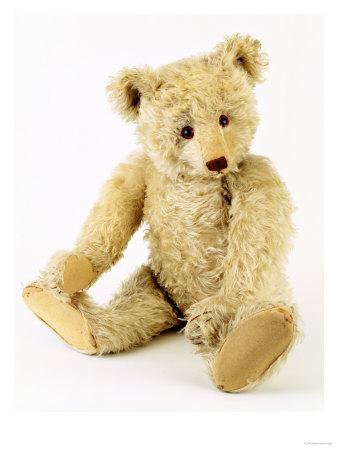Teddy Bears
The first Teddy Bear was named November 15, 1902, when men trapped and chained a great black to a tree endeavoring to improve the luck of a rugged young American President taking a leave after his first year in office to hunt in Mississippi. Eminent as a statesman, soldier, orator, and one of the most widely read writers of his time, Teddy Roosevelt was also a proud hunter and a naturalist. He refused to shoot the tethered bear. The following day a political cartoon captioned "Drawing the Line in Mississippi," illustrated this event in the Washington Post. The half-ton bear was drawn by its artist, Clifford Berryman, not as a wild carnivore, but as a cute cub with sad eyes, round ears, and a button for a nose. He looked more like a doll than an animal and thus he became one.
Within months the President had given his approval to Ideal Toy Company founders, Russian emigre' brothers Morris and Rose Michtom, to apply the name Teddy Bear, to their jointed wool-filled toys. Teddy was an overnight success. By the year 1907, the greatest innovators and artisans in stuffed toy history, the German firm started by wheelchair-bound Margarete Steiff, was turning out almost a million bears annually. Today, Teddy is the most popular of all soft toys. He has starred in classic stories like The Tale of Teddy Bright Eyes (1909), and Winnie the Pooh (1926), and A Bear Called Paddington (1958). He has appeared on lunch boxes, dishware, buttons, sheet music, post cards, and early photographs. All these categories are coveted by antique collectors, but not nearly as much as the huggable old bear himself.
As you can well imagine, old teddies are regularly discovered at tag sales, auctions, church bazaars, shops, and shows-sometimes for only a few dollars. One may be quietly hibernating within a box or trunk in your own attic. The world record price in is a whopping $176,000 achieved for a circa 1905 Steiff bear at a December '94 auction. A similar bear brought $86,000 in 1989, however, before you star tearing apart your attic, take note that these prices are aberrations. As Yogi would say, "They're not your average bear." Teddies a few years old will sell for only a few dollars, and most older bears, even by coveted firms like Steiff, Schuco, Chad Valley, Ideal, or Shackman, bring tens or hundreds, not thousands.
One may be quietly hibernating within a box or trunk in your own attic. The world record price in is a whopping $176,000 achieved for a circa 1905 Steiff bear at a December '94 auction. A similar bear brought $86,000 in 1989, however, before you star tearing apart your attic, take note that these prices are aberrations. As Yogi would say, "They're not your average bear." Teddies a few years old will sell for only a few dollars, and most older bears, even by coveted firms like Steiff, Schuco, Chad Valley, Ideal, or Shackman, bring tens or hundreds, not thousands.
Before investing serious money in pristine old bears you'd be well advised to visit museums, fairs, and auctions, specifically dedicated to old teddies where you can see and handle them. Experts learn the smell and feel of genuine examples that commonly have mohair plush and wood-wool stuffing. Begin your pack with worn examples. They often have an undeniable integrity associated with their very price tag. Who would bother faking a haggard old bear for only five or ten dollars? Next week, we'll talk a little more about the courageous Margarete Steiff and particulars on how to discern the age of precious old teddy bears. Until then, remember that such antiques cannot be bought, only adopted.

